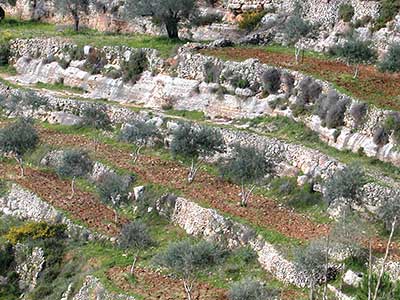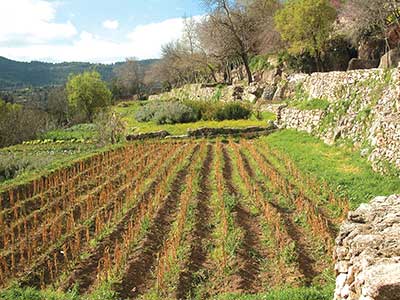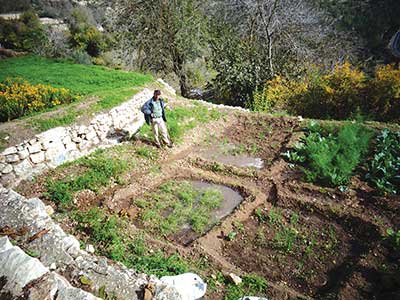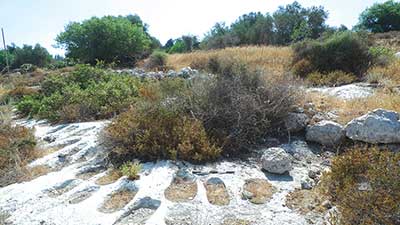 |
 |
| Terraces at Sataf in the Jerusalem Corridor. Photo courtesy of the photo archive of the Jewish National Fund. |
 |
| Spring water at Sataf flowing into the second plot. Photo by Deborah Rubin Fields |
 |
| Patch cultivation or box fields in the Modin area. Photo courtesy of Dr. Rafael Lewis, from a 2017 article co-authored with Prof. Shimon Gibson, “The Origin of Terracing in the Southern Levant and Patch Cultivation/Box Fields” |
By Deborah Rubin Fields
In ancient Jerusalem, a farmer had two choices: Move on (with the hope of doing better elsewhere) or consider clearing rocky hills for cultivation.
How challenging was ancient Jerusalem’s topography and climate? Jerusalem had (and has) no natural resources (including water) or fertile land. It was not located on major trade routes. It had no natural topographical defenses. It is situated on a range of hills running north to south between the Mediterranean Sea to the west and the Jordan Rift Valley to the east. The Hills of Ephraim extend from the Jezreel Valley southward through Shechem (Nablus) and Ramallah. The Judean Hills or Mountains run southward from Jerusalem through Bethlehem and Hebron down to Beer Sheva. The watershed runs through the heart of the range. Jerusalem is about 2,625 feet above sea level. The hills to the north (Shechem – 3,117 feet) and to the south (Hebron – 3,281 feet) are higher than Jerusalem.
Today Jerusalem’s annual rainfall of about 22 inches occurs between November and March. Historically, however, the city experienced variations in rainfall. According to the Israel Weather Channel, a short period of extreme dryness occurred in Israel about 10,000 years ago. Israel began to recover from the last glacial period during the eighth millennium BCE. Temperatures and precipitation rose for a while, and then temperatures rose but precipitation decreased. From 4500 to 3500 BCE, the deserts spread, and Israel experienced hot and dry conditions. After 3500 BCE, temperatures fell and precipitation rose, until about 2300 BCE, when temperatures rose and precipitation fell. Then, around 2000 BCE, precipitation began to increase yet again. While precipitation did fluctuate (including two periods of severe drought), Jerusalem appears to have received more precipitation until the Middle Ages than it does today.
Given the above conditions, it is amazing that any early people stuck around to farm on Jerusalem’s hillsides. Those who did applied the ancient technique of terracing, which, as Nir Hasson of the Israeli newspaper Haaretz has stated, is simply “a series of steps, with the earth held back by a wall of stones to enable tilling the mountainside.”
Establishing Terraces
Setting up and maintaining terraces, however, was easier said than done. After farmers manually cleared the rocks, they hauled over a layer of fertile soil and then lugged back the cleared rocks to create retaining walls, which kept the terraces from collapsing during the rainy season. Only then would they get to planting.
Most farming on the terraced areas of the Judean Mountains was done without artificial irrigation. Farmers harvested grapes, olives, pomegranates and figs that had been watered solely by rainfall.
Archaeological Evidence
We know about these terraces from Jon Seligman, archaeologist and director of external relations and archaeological licensing for the Israel Antiquities Authority. In his doctoral dissertation, “The Rural Hinterland of Jerusalem during the Byzantine period,” he said that Jerusalem’s hilly and rocky topography must have required terraces. In fact the word “step” in Hebrew also refers to terrace.
Intriguingly, in “Mevasseret Yerushalayim: The Ancient Settlement and Its Agricultural Terraces” (The Biblical Archaeologist, winter 1981), Edelstein and Kislev mention that at some Judean Mountain sites such as Mevasseret Yerushalayim, terraces were natural features of the landscape. Unfortunately the existence of terraces did not solve all problems. For instance, archaeologists discovered that the soil in this area was a different color, implying that farmers had dragged in earth from elsewhere. When the terrace was wide enough, the farmer worked with a plow. When it was very narrow, the farmer used a hoe or mattock.
Overall, irrigated areas in the Judean Mountains were quite small. Farmers cultivated vegetables rather than orchards in these irrigated terraces, which consisted of a storage system to hold spring water, slightly raised channels to convey the spring water, and level terraces.
In the valleys of the Judean Mountains, farmers occasionally had to drain excess water after heavy rains. They did this by extending the terracing deep into the valley. Where necessary, they built drain lines and constructed dry stone walls to divert excess water.
Shimon Gibson and Rafael Lewis (“The Origins of Terracing in the Southern Levant and Patch Cultivation/Box Fields,” Journal of Landscape Ecology, December 2017) claim that slopes were terraced initially in the lower parts of hills, closer to the wadi beds. (A wadi is a valley or ravine that is dry except in the rainy season.) The wadi beds were also terraced; newer terraces were built later farther up the slopes after woodland removal.
According to Z. Ron (“Agricultural terraces in the Judean mountains,” Israel Exploration Journal, Jan. 1966), the chief consideration in ancient and Arab settlements in the Judean Mountains was preserving cultivable areas. Hence, most of these settlements ended up on mountain plateaus and adjoining ridge crests.
Inspired by Box Fields
How did early people come to consider terracing? For over 100 years, some archaeologists have suggested that box fields or patch cultivation – the natural step-like appearance of the rocky slopes of hills, with thin layers of chalky marl interposed between limestone or dolomite strata – may have sparked early attempts at terracing.
Gibson and Lewis say that these box fields were undoubtedly used on deforested slopes. Their appearance on Jerusalem’s hilly slopes and in other parts of ancient Israel and Jordan were “sufficiently broad and deep enough to accommodate the root systems of one or sometimes two trees, usually olive trees. While limited in size, they constitute leveled cultivable soils on sloping rocky ground.”
Moreover, Gibson et al. say that box fields also occurred on the hill slope of Sataf, west of Jerusalem, where excavations revealed the remains of houses and installations from the Chalcolithic period (4800-3500 BCE) adjacent to two springs of water. “Due to the very steep angle of the Sataf hill slope, there can be no doubt some form of retained fields must have existed there during that period,” they say. (“The Sataf Project of Landscape Archaeology in the Judaean Hills: A Preliminary Report on Four Seasons of Survey and Excavation (1987-89),” Gibson et al., Levant 23: 29-54, 1991) An agricultural terrace from the Early Bronze I (3330-3050 BCE) was also excavated there, they add.
Preserving the Heritage of Terracing
About 35 years ago, at the Sataf Spring, the Jewish National Fund began to re-establish the ancient terraced fields in order to preserve the landscape and the cultural heritage of terracing. The terraces are more or less the same size as the ancient steps. Trees found at the terraces are from the original species – basically the biblical seven species, which include olives, pomegranates, dates, grapes and figs.
On part of the terraces, trees grow using rainfall only; other parts grow organic vegetables and herbs irrigated by Sataf’s springs, with water traveling via channels that are opened and closed by earth and stone banking. When Jerusalem has a wet winter, the fields are watered solely by rain.
A small staff headed by Gidi Bashan and a large number of volunteers maintain the terraces by hand. No mortar is used in the stone walls, so heavy rains occasionally seep between and eventually push out the stones. Collapsed walls are then rebuilt, one stone at a time. In addition, for a token fee, residents of Jerusalem can farm some 55 small allotments.
Terracing in the Judean Mountains has altered the flow of spring water and runoff water, largely halting the growth of natural vegetation and changing the course of paths and roads.
South and west of Jerusalem, Arab villages continue to use terraces. According to Friends of the Earth-Middle East, Battir, a village south of Jerusalem, still uses irrigated terraces that reportedly date back 4,000 years and are the product of centuries of work. With the billion collected stones “piled one on top of another, generations have engaged in traditional farming.” Spring water – stored in small pools – is channeled to the terraced fields by open canals. Today Battir families grow olives, cabbage and eggplant just as was done in antiquity.
Terraces look different in different areas, depending on what raw materials are available on-site. According to Edelstein et al. (“The Rephaim Valley Project: Villages, Terraces and Stone Mounds: Excavations at Manaḥat, Jerusalem, 1987-1989,” 1998), from the First Temple period (1006 to 586 BCE) onward, thousands of agricultural terraces were in use around the Judean Mountains. They were destroyed and rebuilt during the Hellenistic, Roman and Byzantine periods. They continued to be used by Arab farmers until the Arab-Israeli War of 1948, although Edelstein reports that during the Middle Ages, few Arab families practiced terraced farming around Jerusalem. Still, farmers and Jerusalem residents were able to make a living from a small number of repaired ancient Jerusalem-area terraces. So through perseverance, Jerusalem terraces continued developing for long periods of time. While terraced farming will not provide enough to feed a large and expanding population, many hope that some terraces will continue to be part of Israel’s cultural heritage.
Terrace Farming in Petra
According to Christian Cloke and Cecelia Feldman, aside from periods of flash floods, the ancient city of Petra, located in present-day Jordan, now appears dry. With the skilled terracing of the Nabateans beginning around the first century CE, however, extensive farming and dam construction took place in the region north of the city. The successful terrace farming of wheat, grapes and possibly olives resulted in a vast, green, agricultural “suburb” of Petra in an otherwise inhospitable, arid landscape. This terrace farming remained extensive and robust through the third century CE. (“Research unearths terrace farming at ancient desert city of Petra,” University of Cincinnati, January 2, 2013; https://www.eurekalert.org/pub_releases/2013-01/uoc-rut010213.php)
Terraces in the Andes
Terraces have appeared independently all over the world. For example, the Inca civilization, beginning in the 13th century CE, used terracing in the Andes. According to archaeologist Ann Kendall, the stone retaining walls warmed during the day and slowly released their heat to the soil as temperatures dropped at night, helping sensitive plant roots during occasional frosty nights and expanding the growing season. The terraces also efficiently conserved scarce rain or irrigation water. Even six months after the terraces had been irrigated, they were still damp inside. Today people in the Cuzco region of Peru successfully use Inca terracing techniques. (“Farming Like the Incas,” by Cynthia Graber, Smithsonian, Sept. 6, 2011)
About the author: Deborah Rubin Fields is a features writer who lives in Jerusalem. Her writing largely focuses on Israel, Jewish culture and everyday life issues of the active physically challenged community.

